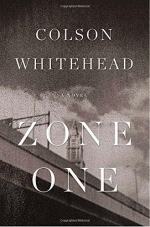|
This section contains 622 words (approx. 2 pages at 400 words per page) |

|
Zone One Summary & Study Guide Description
Zone One Summary & Study Guide includes comprehensive information and analysis to help you understand the book. This study guide contains the following sections:
This detailed literature summary also contains Quotes and a Free Quiz on Zone One by Colson Whitehead.
The following version of this book was used to create this study guide: Whitehead, Colson. Zone One. Doubleday, 2011. First Edition, Hardcover.
Zone One’s limited third-person narrator, Mark Spitz, finds himself in dystopian New York City, after the Earth has been infected by a plague that transforms humans into zombies, referred to by Zone One’s characters as skels and stragglers. These mortally contagious creatures infect living people by biting them, thus turning them into a fellow skel. Mark Spitz and his fellow sweepers are tasked to clean out all skels and stragglers from a small area of Manhattan called Zone One, in the hopes of resettling the area with the living. Over a three-day period, Mark Spitz and his fellow sweepers journey through lower Manhattan, detailing the horrific apocalyptic reality in which they live.
In the plague’s chaos, a nascent government has formed in Buffalo, New York. They are a corporate-minded institution attempting to rebrand survival as honorable and optimistic. Buffalo has developed refugee camps around the country, and hopes to successfully cleanup Manhattan so they can resettle a small population there. Before Buffalo became the survivalist headquarters, survivors bounced from place to place, killing skels as they went, doing whatever they could to stay alive. Mark Spitz perused his hometown Long Island in the immediate aftermath of the plague, winding up in various northeast states before discovering a refugee camp called Happy Acres. At Happy Acres, Mark Spitz hears of the cleanup effort in Manhattan and longs to be a part of it.
The narrative is largely comprised of flashbacks. In a sporadic style, Mark Spitz recalls his life before the plague, proclaiming himself as a mediocre person who learned to get by in school, work, and relationships with minimal effort. His pre-plague life was uninspiring—he had few friends and lived with his parents at the time of Last Night, the term referring to the night society collapsed. Yet, as often as Mark Spitz dives into flashbacks, he is reluctant to linger on memories or emotions for too long—survivors who cling too close to the past end up dying, he knows, so he detaches. In plague times, Mark Spitz is far from mediocre. He has found his purpose in killing skels, and excels at his job as a sweeper. He belongs in the apocalyptic city.
Although the novel is peppered with flashbacks detailing Mark Spitz’s past and plague survival story, in present time he is with his sweeper team, Omega Unit, cleaning out Manhattan high rises. Omega Unit is comprised of Mark Spitz, Kaitlyn, and Gary. None of them, or other sweepers, have military experience, but are armed with artillery and combat weapons. The military initially swept through Manhattan after the plague; many soldiers were bitten and became skels, however. Mark Spitz is skeptical of Buffalo’s rebuilding effort and senses something secretive about their mission. The border wall that is barricading Zone One from the rest of skel-ridden Manhattan seems to be wavering, and Mark Spitz senses it will soon fall. Mark Spitz’s barricade distrust leads to broader themes involving democracy, institutional structures, and systematic reliance. Mark Spitz is grateful for such systems, but longs to live outside of their authority.
On Sunday, the third and final day of the novel’s narration, the barricade securing Zone One falls. Mark Spitz attempts to secure the safety of his sweeper team, but soon realizes that all his lost: the world is ending again. Yet, he does not panic. Mark Spitz thrives in New York City’s apocalypse, and lavishes the challenge of killing skels. The novel ends as he walks into an invading swarm of zombies, firing into their bloodthirsty mouths.
Read more from the Study Guide
|
This section contains 622 words (approx. 2 pages at 400 words per page) |

|



